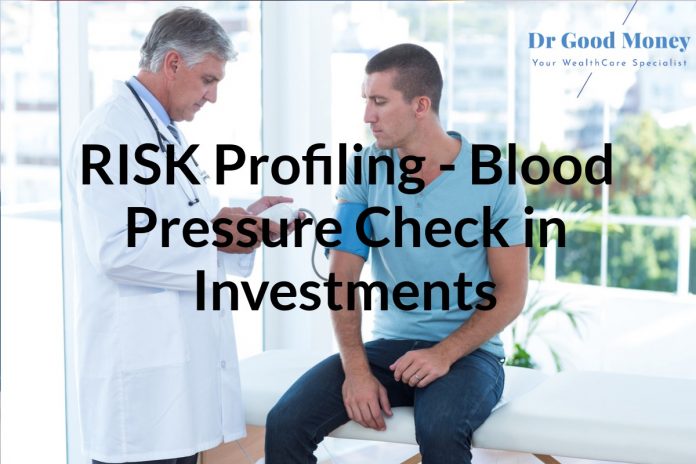Risk profiling is an integral part of the financial planning exercise and investment advisory process. Nowadays Risk profiling has also become a regulatory requirement as SEBI has made it compulsory for Registered investment advisors.
It’s like before prescribing on some medicines a doctor should know and also prefers to check, the blood pressure of the patient, as some of the medicines might impact the same.
Same way, the adviser should also know how sensitive the Investor is towards volatility in the Investment market and what composition of debt and equity should be given, which is comfortable to persona.
Investment advisors can advise on asset allocation and suitable investments only as per the Risk tolerance level of the investor. This post is regarding what risk profiling actually is, why it is important, and how risk tolerance level leads to suitable asset allocation.
What is Risk Profiling?
The term risk has a different meaning to different people. Many call it uncertainty, many call it an opportunity. Many people assume it as a chance of loss. (Read:5 Risks Doctors are exposed to and how to manage them)
In simple terms, risk means a possibility of having 2 outcomes of an activity or action out of which one can be favorable, and others can be unfavorable. So, where there is a chance of loss, it also has an equal chance of gain too.
FREE Download
YOUR FINANCIAL DATA
RECORD KEEPER
Organize and Collate data at a Single Place for easy Access and Management
Risk profiling is the evaluation process to find out an individual’s willingness to take the risk. This process defines the risk tolerance level of the investor after taking into account the understanding and acceptability of risk in different situations of life.
Risk tolerance score comes out after taking into account not only the psychological factors but also your investment horizon and investment objective.
Risk Tolerance Vs Risk Perception
Remember when your patient says, he is fine, believing that nothing could hap[pen to him and he is fine otherwise. But when any medicine reacts or impacts the otherwise Blood Pressure, he puts the blame on the doctor.
His response was as per his Risk Perception. His feelings at that particular time, comfort with the environment around, his views about himself, and many other positive or negative factors played their role here. In good times or positive environment, people feel good about themselves and misjudge the risk around. The same happens at opposite times.
The same way people enter into risky investment products like- equity, believing that their risk tolerance level is very high and thus ready to bear the volatility. The same investor starts blaming the government, economy, inflation, or may start calling equity investments as gambling in the market downturn.
Why so? because he’s misjudged his risk tolerance level. He enters with a perception in mind that he’s young or having a good inflow of money or having very long term goals etc. so he should be very high in equity allocation.
But after a few months, he found that he could not handle the real volatility.
So what actually has changed in these months is his risk perception.
Risk Perception is what you as an investor personally feels about your risk tolerance level.
Buying more when markets are moving up and selling more when markets are going down is the result of your personal risk perception.
Research has shown that bull and bear market phases hardly change the risk tolerance level of investor, but what changes is the risk perception.
Investors who are not following a proper process in their investments often fall prey to their wrong decision making due to their own risk perception.
Why risk profiling is important before making investments?
The same reason, as to why Blood Pressure checks are important before medication.
One of life’s most unpleasant surprises is to discover you have suffered a significant loss because you underestimated the risk involved.
Similarly, it can be almost as disappointing to find you have not made the most of the opportunities because you overestimated the risks involved.
While making investments, it is as important to understand your reaction to different outcomes as it is to understand the probable outcomes.
How risk profiling leads to suitable Asset allocation?
The main reason for doing risk profiling is to figure out a suitable asset allocation as per your risk tolerance level.
(Also Read: Asset Allocation- The Balanced Diet to your investment portfolio)
Suitability of Investment advice has also become the prime concern of the regulator and this is one of the reasons it came up with the regulation of investment advisors. And thus it is very important for investors to understand the suitability of an investment portfolio.
The Composition of investment assets in a portfolio should commensurate with the risk tolerance level of the investor.
Defensive and growth assets should be adequately distributed in the portfolio. Once you know how much volatility can you handle then only you can decide what equity allocation you should have and in what funds.
We at Drgoodmoney use Finametrica, an Australia based, psychometric risk profiling tool that provides us with deep insights into the risk and returns involved in different asset allocations. It also tells us the movements of different Investment portfolios with losses and profits it has generated in the past years. It provides a good base to design a suitable investment asset allocation for our doctor clients.






